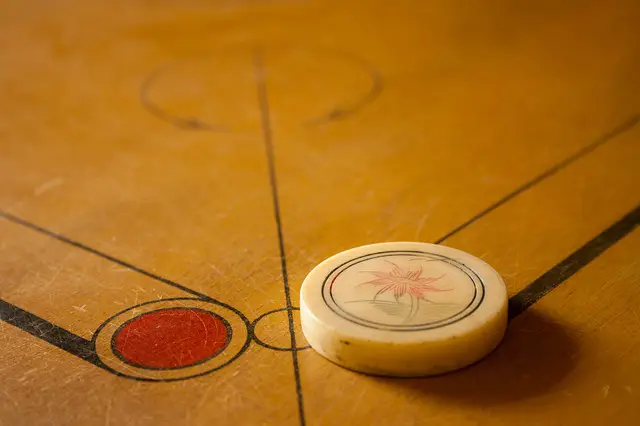How to play carrom | Basic Playing Technique of Carrom

CARROM TECHNIQUES
At the carrom, you can play with any finger and any hand, the important thing is to feel comfortable with your grip. There is no such thing as a perfect grip, but you have to keep in mind a few basic principles:
• the index and middle fingers are the fingers that are used to pull because they are the ones that allow the most control in precision and power while the thumb is used for back shots;
• the finger must be glued to the puck or placed just behind it and well aligned in the axis of the shot so that it does not send the puck elsewhere; – try to keep your finger as straight as possible so as not to deflect the puck when shooting.
Shooting with the index finger
The index finger is retained by the thumb and the other fingers can be rested on the plate for more stability. This easy to play grip can be very precise but lacks a bit of power. To have more strength, we can come and hold the index finger with the middle finger, ring finger or little finger. A little more difficult to master, these grips provide more power and can therefore be used to break.
Also Read
The shooting with the index finger on the carrom
SHOOTING with the Major
Grips with the middle finger do not have any real advantages over the index finger.
Playing with the middle finger is mostly a choice and means that the player feels more comfortable and comfortable with this finger than with the index finger. The scissor grip is one of the most powerful grip but also difficult to master with precision. You can therefore with a little practice use it to break and then use the grip of your choice.
The shooting with the middle finger on the carrom
Thumb shooting
This grip is used for “backshots” or back shots. The thumb is retained either by the index or middle finger at the convenience of the player. A little trick for these shots is to orient your forearm perpendicular to the axis of the shot.
For shots to the right for right-handed people, and to the left for left-handed people, you can play with your “weak” hand but also use the scissor grip in order to keep your “strong” hand to shoot. With a little practice, we realize that this grip is the most suitable for these shots.
Shooting with the thumb on the carrom
THE DIRECT BREAKING
This way of breaking applies during a doubles game. His partner being in front of you, we can then “send” the pawns to him as if we were making a pass. This is why we break live without the puck making a band. To put at least one pawn by breaking, we orient a line of 5 pawns with a blank at each end in the diagonal of the board. From bottom right to top left when breaking on the right, as in the example above, and opposite when breaking on the left. It is essential that the 5 aligned pawns all touch each other. We then place the puck next to the red dot and strike the pawns quite hard at the place indicated by the arrow.
The direct breakage at the carrom
INDIRECT BREAKAGE
Breaking in indirect means that the puck hits the band before hitting the pawns. In this way, we bring our pawns to our side and at the same time, we move those of the opponent away from his camp. This way of breaking is therefore used when playing singles.
The way to place your pawns is the same as for the live breakout except that you orient the line of 5 pawns differently. From top to right to bottom to left for a right break (as above) and opposite for a left break. By placing the puck on the red point, we then take as a reference point the small arrow on the right of the upper right circle and we pull hard in that direction.
Also Read
The carrom may seem very simple at first. However, technique is very important here and if you want to progress you will have to master the basic techniques a little.
Without pretending to present a complete carrom course here, we will try to present the basic techniques that will allow you to progress quickly.
Indirect carrom breakage
The front band
As points A and C show, if the pawn goes into a hole on the side of the base having touched the opposite strip, we speak of a front strip. This move is useful when the hole on the opposite side is blocked by an opponent’s pawn. Sometimes, some pawns close to the opposite strip are not easily playable in cut. They can then be played in front band. When playing a pawn this way, it is preferable for the puck to go in the opposite direction to that of the pawn. If this is not done, the puck will hit the pawn twice and the pawn will stay in the same place.
If the line of the puck crosses that of the pawn and the pawn has entered a strip, the move is called a crossed forward strip because the pawn crosses the path of the puck. This move is played when the opposite hole is blocked by an opponent’s pawn, it makes it possible to move this pawn and free the hole for other pawns (see point B).
